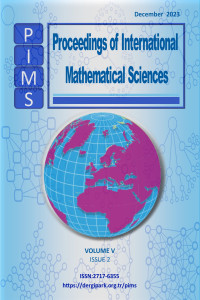Abstract
In the first countable spaces many topological concepts such as open and closed subsets; and continuous functions are defined via convergent sequences. The concept of limit defines a function from the set of all convergence sequences in X to X itself if X is a Hausdorff space. This is extended not only to topological spaces but also to sets. More specifically a G-method is defined to be a function defined on a subset of all sequences (see [7] and [10]). We say that a sequence x = (x_n) G-convergences to a if G(x) = a. Then many topological objects such as open and closed subsets and many others including these sets have been extended in terms of G-convergence. G-continuity, G-compactness and G connectedness have been studied by several authors ([1], [2], [3], [4]). On the other hand we know that in a topological space X, a sequence (x_n) converges to a point a ∈ X if any open neighbourhood of a includes all terms except finite number of the sequence. Similarly we define a sequence (x_n) to be G-sequentially converging to a if any G-open neighbourhood of a includes almost all terms. In this work provided some examples we indicate that G-convergence and G-sequentially convergence are different. We will prove that G-closed and G-sequentially closedness of subsets and therefore many others are different.
References
- H. Çakallı, On G-continuity, Comput. Math. Appl., Vol. 61, No.2, pp. 313-318, (2011).
- H. Çakallı, Sequential definitions of connectedness, Appl. Math. Lett. Vol.25, No.3, 461-465 (2012).
- O. Mucuk, H. Çakallı, G-sequentially connectedness for topological groups with operations , Filomat, 32: 3 1079-1089 (2018).
- O. Mucuk and T. Şahan, On G-sequential Continuity, Filomat Vol.28, No.6, pp.1181-1189, (2014).
- E. Savaş G.Das, On the A-continuity of real functions, İstanbul Univ. Fen Fak. Mat Derg. 3 (1994) 61-66.
- J.Borsik and T.Salat, On F-continuity of real functions, Tatra Mt. Math. Publ 2, (1993), 37-42.
- J. Connor, K.-G. Grosse-Erdmann, Sequential definitions of continuity for real functions, Rocky Mountain J. Math. , Vol. {33}, No.1, 93-121 (2003).
- H. Çakallı, New kinds of continuities, Comput.Math. Appl. 61, (2011) 960-965.
- O. Mucuk, T. Şahan, On G-sequential Continuity, Filomat 28-6 (2014) 1181-1189.
- S. Lin, L. Liu, G-methods, G-spaces and G-continuity in topological spaces, Topology Appl., 212 (2016) 29-48.
- Wu. Yongxing Lin., Fucai, The G-connected property and G-topological groups, (2019).
- R. Brown and O. Mucuk, Covering groups of non-connected topological groups revisited, Mathematical Proceedings of the Cambridge Philosophical Society, 115 (1994) 97-110.
- L. Liu and Z. Ping, Product Methods and G-Connectedness. Acta Math. Hungar. 162,(2020) 1–13.
- O. Mucuk, S. Behram, H. Çakallı. G-connectedness for product spaces, ICMS2021(AIP Conference Proceedings) 2483, 020008 (2022); https://doi.org/10.1063/5.0115542.
- O. Mucuk, S. Behram, G-sequential methods in product spaces, ICMS2021(AIP Conference Proceedings) 2483, 020007 (2022); https://doi.org/10.1063/5.0115533.
- Vijaya Shanthi, P., Kannan, J. On countably G-Compactness and sequentially GO-compactness. The Korean Journal of Mathematics 29 (2021), 555-561.
- O. Mucuk, S. Behram, Counter examples of G- convergent method, ICMS2022(AIP Conference Proceedings) 2879, 070001 (2023); https://doi.org/10.1063/5.0175384.
Abstract
References
- H. Çakallı, On G-continuity, Comput. Math. Appl., Vol. 61, No.2, pp. 313-318, (2011).
- H. Çakallı, Sequential definitions of connectedness, Appl. Math. Lett. Vol.25, No.3, 461-465 (2012).
- O. Mucuk, H. Çakallı, G-sequentially connectedness for topological groups with operations , Filomat, 32: 3 1079-1089 (2018).
- O. Mucuk and T. Şahan, On G-sequential Continuity, Filomat Vol.28, No.6, pp.1181-1189, (2014).
- E. Savaş G.Das, On the A-continuity of real functions, İstanbul Univ. Fen Fak. Mat Derg. 3 (1994) 61-66.
- J.Borsik and T.Salat, On F-continuity of real functions, Tatra Mt. Math. Publ 2, (1993), 37-42.
- J. Connor, K.-G. Grosse-Erdmann, Sequential definitions of continuity for real functions, Rocky Mountain J. Math. , Vol. {33}, No.1, 93-121 (2003).
- H. Çakallı, New kinds of continuities, Comput.Math. Appl. 61, (2011) 960-965.
- O. Mucuk, T. Şahan, On G-sequential Continuity, Filomat 28-6 (2014) 1181-1189.
- S. Lin, L. Liu, G-methods, G-spaces and G-continuity in topological spaces, Topology Appl., 212 (2016) 29-48.
- Wu. Yongxing Lin., Fucai, The G-connected property and G-topological groups, (2019).
- R. Brown and O. Mucuk, Covering groups of non-connected topological groups revisited, Mathematical Proceedings of the Cambridge Philosophical Society, 115 (1994) 97-110.
- L. Liu and Z. Ping, Product Methods and G-Connectedness. Acta Math. Hungar. 162,(2020) 1–13.
- O. Mucuk, S. Behram, H. Çakallı. G-connectedness for product spaces, ICMS2021(AIP Conference Proceedings) 2483, 020008 (2022); https://doi.org/10.1063/5.0115542.
- O. Mucuk, S. Behram, G-sequential methods in product spaces, ICMS2021(AIP Conference Proceedings) 2483, 020007 (2022); https://doi.org/10.1063/5.0115533.
- Vijaya Shanthi, P., Kannan, J. On countably G-Compactness and sequentially GO-compactness. The Korean Journal of Mathematics 29 (2021), 555-561.
- O. Mucuk, S. Behram, Counter examples of G- convergent method, ICMS2022(AIP Conference Proceedings) 2879, 070001 (2023); https://doi.org/10.1063/5.0175384.
Details
| Primary Language | English |
|---|---|
| Subjects | Applied Mathematics (Other) |
| Journal Section | Articles |
| Authors | |
| Early Pub Date | December 26, 2023 |
| Publication Date | December 31, 2023 |
| Submission Date | October 11, 2023 |
| Acceptance Date | November 20, 2023 |
| Published in Issue | Year 2023 Volume: 5 Issue: 2 |

The published articles in PIMS are licensed under a Creative Commons Attribution-NonCommercial 4.0 International License.


